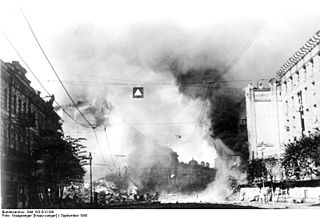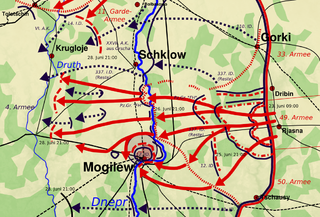
The First Battle of Kiev was the German name for the major battle that resulted in an encirclement of Soviet troops in the vicinity of Kiev during World War II, the capital and most populous city of the Ukrainian Soviet Socialist Republic. This encirclement is the largest encirclement in the history of warfare by number of troops. The battle occurred from 7 July to 26 September 1941 as part of Operation Barbarossa, the Axis invasion of the Soviet Union.

The first Battle of Smolensk was a battle during the second phase of Operation Barbarossa, the Axis invasion of the Soviet Union, in World War II. It was fought around the city of Smolensk between 10 July and 10 September 1941, about 400 km (250 mi) west of Moscow. The Ostheer had advanced 500 km (310 mi) into the USSR in the 18 days after the invasion on 22 June 1941.

The Western Front was a front of the Red Army, one of the Red Army Fronts during World War II.

The Battle of Uman was the World War II German offensive in Uman, Ukraine against the 6th and 12th Soviet Armies. In a three-week period, the Wehrmacht encircled and annihilated the two Soviet armies.
The XXXIX Panzer Corps was a German panzer corps which saw action on the Western and Eastern Fronts during World War II.

The Vitebsk–Orsha offensive was part of the Belorussian strategic offensive of the Red Army in summer 1944, commonly known as Operation Bagration. During the offensive, Soviet troops captured Vitebsk and Orsha. A Soviet breakthrough during the offensive helped achieve the encirclement of German troops in the subsequent Minsk offensive.

The Mogilev offensive was part of the Belorussian strategic offensive – commonly known as Operation Bagration – of the Red Army on the Eastern Front of World War II in the summer of 1944. Its goals were to capture the city of Mogilev and to pin down and trap the bulk of the German Fourth Army. The offensive fulfilled both objectives.

The 268th Infantry Division was a German Army division active and operating during the Second World War.
The 50th Army was a Soviet field army during World War II. It was formed in mid-August, 1941 and deployed on the southwest approaches to Moscow. Partly encircled and destroyed by German Second Panzer Army in the opening stages of Operation Typhoon, enough of the army escaped that it could be reinforced to successfully defend the city of Tula in November. It was at this time that the 50th came under the command of Lt. Gen. Ivan Boldin, who continued in command until February, 1945. During most of its career the army was relatively small and accordingly served in secondary roles. It finished the war in East Prussia, under the command of Lt. Gen. Fyodor Ozerov, as part of 3rd Belorussian Front.
The 61st Rifle Corps was a Red Army infantry corps during World War II, formed twice. The 61st Rifle Corps was formed firmed in Tula during September 1939. After Operation Barbarossa, it was transferred to the front in Belarus and fought in the Battle of Smolensk. After suffering heavy losses at Smolensk, it was disbanded in early August 1941. Reformed in spring 1943, the corps fought in Operation Kutuzov, the Lublin–Brest Offensive and the Berlin Offensive. The corps was disbanded after the end of the war in summer 1945.
The 20th Mechanized Corps was a mechanized corps of the Red Army. Formed in March 1941, the corps was almost entirely destroyed in the Battle of Białystok–Minsk and the Battle of Smolensk, in which it defended Mogilev.

Fyodor Alexeyevich Bakunin was a Soviet Army major general. Bakunin briefly served in the Imperial Russian Army in 1917 and in 1919 joined the Red Army, fighting in the Russian Civil War. He became an officer and in 1938 was appointed to lead the 11th Rifle Division. A year later Bakunin became commander of the 2nd Rifle Corps. Nearly a year later, he became commander of the 61st Rifle Corps. The corps fought in the Battle of Smolensk after the German invasion of the Soviet Union. Bakunin led the corps during the Siege of Mogilev, in which it was destroyed. He escaped the encirclement and became a teacher at the Frunze Military Academy. In the fall of 1943 he was given deputy command of the 10th Rifle Corps and in May 1944 command of the 63rd Rifle Corps. Bakunin led the corps until 1947, when he retired.
Mikhail Timofeyevich Romanov was a Red Army major general. Romanov served with the Imperial Russian Army in World War I and joined the Red Army; he held command positions during the Russian Civil War. In 1939, Romanov became commander of the 185th Rifle Division. He attended courses at the Military Academy of the General Staff and became commander of the 172nd Rifle Division. Romanov led the division in the Siege of Mogilev and was taken prisoner during the Soviet breakout attempt. He was sent to the Hammelburg POW camp and died there in December 1941.
Leonid Grigorevich Petrovsky was a Soviet lieutenant general. He was the oldest son of Grigory Petrovsky. He was born in what is now Donetsk Oblast in Ukraine. He was promoted to Komkor from Komdiv in 1937. While in command of forces in Central Asia, he was removed from command and expelled from the army. He was not executed like many of his colleagues. In 1940, he was reinstated in the army. He was a recipient of the Order of the Red Banner, the Order of the Red Star and the Order of the Patriotic War. Less than a month after his death, his younger brother, Peter was executed on September 11, despite a request from his father for his release.

The 61st Cavalry Division was a cavalry division of the Red Army that served in the first years of the Great Patriotic War. It was formed in September – October, 1941, and saw its first actions to the south of Stalingrad during the German siege of that city in the autumn of 1942. When the Soviet counteroffensive, Operation Uranus, began in November the 61st formed a significant part of the mobile forces of its 51st Army. After the positions of Romanian 4th Army were broken through the division took part in the exploitation to the southwest, but became overextended and vulnerable to the mobile German reinforcements arriving to attempt a breakthrough to their Sixth Army. The 61st suffered such severe losses that it had to be withdrawn to the reserves in December, and was later disbanded.
The Roslavl–Novozybkov offensive was an offensive conducted by the Red Army's Bryansk Front against the German 2nd Panzer Group and 2nd Army in Bryansk Oblast and parts of Sumy Oblast on the Eastern Front of World War II between 30 August and 12 September 1941, part of the Battle of Smolensk in Soviet historiography.

The Battle of Nevel was a successful military operation conducted by the Red Army in the Pskov Oblast of western Russia and in northern Belarus during World War II, from October 6 to roughly December 16, 1943, although fighting persisted in the area into the new year.
The 204th Rifle Division was twice formed as an infantry division of the Red Army after a motorized division of that same number was destroyed in the first weeks of the German invasion of the Soviet Union. The first formation was based on the shtat of July 29, 1941, and it then remained for nine months in the far east of Siberia training and organizing before it was finally sent by rail to the Stalingrad region in July 1942 where it joined the 64th Army southwest of the city. During the following months it took part in the defensive battles and later the offensive that cut off the German 6th Army in November. In the last days of the battle for the city it took the surrender of the remnants of a Romanian infantry division. Following the Axis defeat the division was recognized for its role when it was redesignated as the 78th Guards Rifle Division on March 1, 1943.
The 1940 formation of the 160th Rifle Division was an infantry division of the Red Army, formed as part of the prewar buildup of forces, based on the shtat of September 13, 1939. The division completed its formation at Gorki in the Moscow Military District and at the time of the German invasion of the Soviet Union was in the same area, assigned to the 20th Rifle Corps in the Reserve of the Supreme High Command. It was moved west by rail to join the 13th Army of Western Front in the first days of July 1941 in the Mogilev area. At the end of the month the division was assigned to the reserves of Central Front before becoming part of Operations Group Akimenko in the reserves of Bryansk Front. In mid-September it was encircled and forced to break out; in the process it lost its commanding officer, much of its command staff and so many men and heavy weapons that it was briefly written off. Its number was reallocated to the 6th Moscow Militia Division and for the next 18 months there were two 160th Rifle Divisions serving concurrently. By the start of Operation Typhoon at the end of September it was in Operations Group Ermakov; while falling back to southwest of Kursk it managed to avoid encirclement but remained barely combat-effective due to its heavy losses.
The 187th Rifle Division was an infantry division of the Red Army, originally formed just after the start of the Second World War, based on the shtat of September 13, 1939. It began forming on that same date, in the Kharkov Military District, and while it was officially part of the Active Army when the invasion of Poland began four days later it was not nearly complete enough to take part. At the start of the German invasion it was in reserve in the 45th Rifle Corps, but soon began moving to the front, again joining the Active Army on July 2, 1941. It was initially assigned to 21st Army in Western Front, then moved to 13th Army in the same Front, before returning to the 21st. Part of the division was encircled and destroyed in the hard-fought battle for Mogilev. Late in August the 187th was transferred, with its Army, to Bryansk Front, just days before the 2nd Panzer Group began driving south to encircle Southwestern Front east of Kyiv. The division was directly in the path of this drive, and despite being withdrawn across the Desna River on September 5, it was pocketed by September 16 and largely destroyed within days, although not officially disbanded until November 1.










